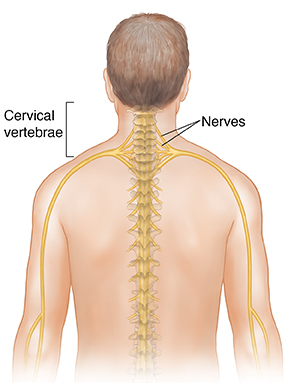Understanding Cervical Radiculopathy
Understanding Cervical Radiculopathy

Vertebrae. These are bones that stack to form the spine. The cervical spine contains the 7 vertebrae in the neck.
Disks. These are soft pads of tissue between the vertebrae. They act as shock absorbers for the spine.
The spinal canal. This is a tunnel formed within the stacked vertebrae. The spinal cord runs through this canal.
Nerves. These branch off the spinal cord. As they leave the spinal canal, nerves pass through openings between the vertebrae. The nerve root is the part of the nerve that is closest to the spinal cord.
With cervical radiculopathy, nerve roots in the neck become irritated. This leads to pain and symptoms that can travel to the nerves that go from the spinal cord down the arms and into the torso.
What causes cervical radiculopathy?
Aging, injury, poor posture, and other issues can lead to problems in the neck. These problems may then irritate nerve roots. These include:
Damage to a disk in the cervical spine. The damaged disk may then press on nearby nerve roots.
Degeneration from wear and tear, and aging. This can lead to narrowing (stenosis) of the openings between the vertebrae. The narrowed openings press on nerve roots as they leave the spinal canal.
An unstable spine. This is when a vertebra slips forward. It can then press on a nerve root.
There are other, less common causes of pressure on nerves in the neck. These include infection, cysts, and tumors.
Symptoms of cervical radiculopathy
These include:
Neck pain
Pain, numbness, tingling, or weakness that travels down the arm
Loss of neck movement
Muscle spasms
Treatment for cervical radiculopathy
In most cases, your healthcare provider will first try treatments that help relieve symptoms. These may include:
Prescription or over-the-counter pain medicines. These help relieve pain and swelling.
Cold packs. These help reduce pain.
Resting. This involves avoiding positions and activities that increase pain.
Neck brace (cervical collar). This can help relieve inflammation and pain.
Physical therapy, including exercises and stretches. This can help decrease pain and increase movement and function.
Shots of medicinesaround the nerve roots. This is done to help relieve symptoms for a time.
In some cases, your healthcare provider may advise surgery to fix the underlying problem. This depends on the cause, the symptoms, and how long the pain has lasted.
Possible complications
Over time, an irritated and inflamed nerve may become damaged. This may lead to long-lasting (permanent) numbness or weakness. If symptoms change suddenly or get worse, be sure to let your healthcare provider know.
When to call your healthcare provider
Call your healthcare provider right away if you have any of these:
New pain or pain that gets worse
New or increasing weakness, numbness, or tingling in your arm or hand
Bowel or bladder changes
Updated:
June 19, 2017
Sources:
Manchikanti L. Cervical Radiculopathy. In: Waldman SD, editor. Pain Management. Philadelphia: Elsevier; 2011. p. 522-8., Mostoufi Al. Cervical Radiculopathy. In: Frontera WR, et al, editors. Essentials of Physical Medicine and Rehabilitation: Musculoskeletal Disorders, Pain, and Rehabilitation. 3 ed. Philadelphia: Saunders; 2015. p. 22-30., Robinson J, Kothari MJ. Clinical features and diagnosis of cervical radiculopathy. Up To Date. August 13 ed: Up To Date; 2014. p. 16., Robinson J, Kothari MJ. Treatment of cervical radiculopathy. Up To Date. May 7, 2015 ed: Up To Date; 2015. p. 13., Tuttle J, Chutkan N. Cervical Radiculopathy. In: Shen FH, el al, editors. Textbook of the Cervical Spine. Philadelphia: Saunders; 2015. p. 131-4.
Reviewed By:
Bellendir, Trina, MSPT, CLT,Image reviewed by StayWell medical illustration team.,Joseph, Thomas N, MD